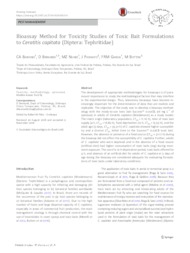Bioassay method for toxicity studies of toxic bait formulations to Ceratitis capitata (Diptera: Tephritidae).
Bioassay method for toxicity studies of toxic bait formulations to Ceratitis capitata (Diptera: Tephritidae).
Autoria: BARÔNIO, C. A.; BERNARDI, D.; NUNES, M. Z.; PASINATO, J.; GARCIA, F. R. M.; BOTTON, M.
Resumo: The development of appropriate methodologies for bioassays is of paramount importance to study the methodological factors that may interfere in the experimental design. Thus, laboratory bioassays have become increasingly important for the determination of data that are realistic and replicable. The objective of the study was to develop a bioassay methodology with the ready-to-use toxic bait Success ? 0.02CB, 96 mg L−1 of spinosad, in adults of Ceratitis capitata (Wiedemann) as a study model. The insect origin laboratory population, LT 50= 11.16 h), time of toxic bait supply (4 h, LT 50= 16.85 h), food deprivation (12 h, LT 50= 15.55 h), and the adult age (5 days, LT 50= 35.31 h) of C. capitata showed higher susceptibility and a shorter LT 50 lethal time to the Success? 0.02CB toxic bait. However, the absence or presence of a food source (LT 50≈31.17 h) during the bioassay did not affect the susceptibility of C. capitata. Further, adults of C. capitata who were deprived and in the absence of a food source (artificial diet) had higher consumption of toxic baits (mg) during treatment exposure. The use of a 12-h deprivation period, toxic baits offered for 4 h, and absence of an artificial diet for adults of C. capitata at 5 days of age during the bioassay are considered adequate for evaluating formulations of toxic baits under laboratory conditions. Keywords: Toxicity, methodology, spinosad, Mediterranean fruit fly
Ano de publicação: 2018
Tipo de publicação: Artigo de periódico
Unidade: Embrapa Uva e Vinho
Palavras-chave: Mediterranean fruit fly, Methodology, Spinosad, Toxicity
Observações
1 - Por padrão são exibidas publicações dos últimos 20 anos. Para encontrar publicações mais antigas, configure o filtro ano de publicação, colocando o ano a partir do qual você deseja encontrar publicações. O filtro está na coluna da esquerda na busca acima.
2 - Para ler algumas publicações da Embrapa (apenas as que estão em formato ePub), é necessário ter, no celular ou computador, um desses softwares gratuitos. Sistemas Android: Google Play Livros; IOS: iBooks; Windows e Linux: software Calibre.
Acesse outras publicações
Acesse a Base de Dados da Pesquisa Agropecuária (BDPA) para consultar o acervo completo das bibliotecas da Embrapa.

